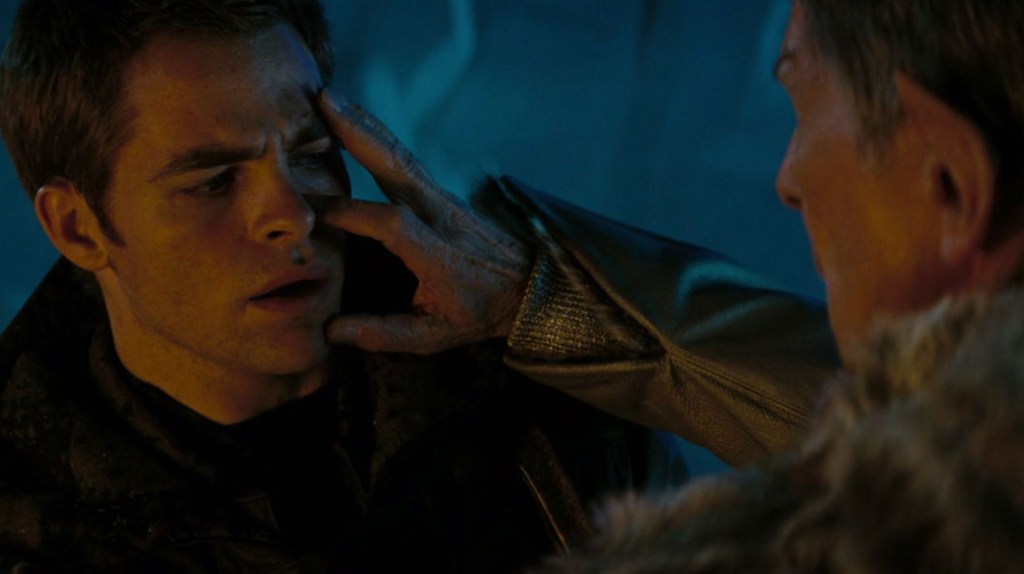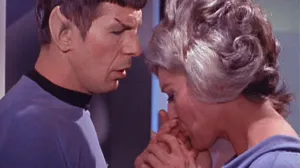Over nearly six decades, the Vulcan mind meld has become one of Star Trek’s most effective and recognizable sci-fi devices, though arguably one of its most overused. By the end of The Original Series, a ritual that was once described by Spock as deeply personal for Vulcans—a ritual which could even become dangerous if used on other species, had become something of a fix all solution. Much like the Doctor’s trusty sonic screwdriver (seriously, is there anything that thing can’t do?!) the mind meld started to be deployed so often that it lost much of its poignancy and dramatic weight.
Videos by ComicBook.com
But Strange New Worlds may have just given the mind meld back its significance. In the season 3 finale, “New Life and New Civilizations”, Spock’s unexpected bonding with Kirk not only reframes how Star Trek’s most famous friendship began, but also restores the gravity of the practice. The retcon may bend canon, but it also fixes one of the franchise’s oldest storytelling problems.
A Retcon That Changed Everything

The finale of Strange New Worlds delivered an unexpected surprise for fans when it gave us what is now officially the first ever mind meld between Kirk and Spock (previously thought to have happened in TOS season 3’s “Spectre of the Gun” and later confirmed by novel Strangers from the Sky). When faced with the impossible tactical challenge of firing phasers manually from two ships simultaneously, Spock suggests a mind meld with Kirk (currently the pilot of the Farragut) to synchronize their actions—and in doing so, inadvertently forges the beginnings of the famous friendship that would echo across the decades. Not only did this retcon change what we thought we knew about their first meld or how Spock and Kirk became friends, suggesting their iconic bond wasn’t necessarily something that grew gradually over years of missions, but instead was fast-tracked by this intimate psychic connection—it also directly contradicted canon from The Original Series.
In the episode “Dagger of the Mind,” Spock tells Dr. McCoy he has never attempted a mind meld with a human before. He even calls it a private Vulcan discipline, insisting it could be dangerous when used on humans. That assertion had already been called in to question by Strange New Worlds when Spock melded with La’an in “Memento Mori,” but his melding with Kirk seemingly doubles down on this contradiction. At this point, with Spock seemingly willing to meld with literally any takers, the claim in “Dagger of the Mind” seems impossible to reconcile! But perhaps this move is deliberate.
For purists, the apparent changes to canon brought about by Strange New World’s finale might be nothing but irksome, but when you look at this retcon in context, maybe the writers are less concerned with preserving old continuity and more concerned with giving weight to a ritual that should never have been treated lightly in the first place.
Restoring the Power of Star Trek’s Most Famous Bond

By the time Star Trek TOS wrapped up in 1969, the mind meld had shifted somewhat from a rare, intimate act to a convenient plot speeder-alonger. Just say the magic words “my mind to your mind” and hey presto, problem solved. The repetition drained the practice of much of its mystique, turning it into one of TOS’s most convenient (and at times least believable) tools in the Vulcan toolkit. Leonard Nimoy himself even expressed frustration in his autobiography, noting that the mind meld had been reduced to something of an easy device to move the plot along, rather than a sparingly used sacred Vulcan practice.
The problem persisted into later Star Trek projects too. Fans may remember the divisive moment in J.J. Abrams’ Star Trek (2009), where “Spock Prime” (Leonard Nimoy reprising his famous role) essentially downloaded his memories into Chris Pine’s Kirk through a meld. Many considered it a clumsy way to accelerate Kirk’s arc, not to mention the somewhat non-consensual vibe of the meld and Spock basically shoe-horning his memories of a very different Kirk into a young and confused James T.
The brilliance of Strange New Worlds’ approach is that it reframes a once-abused tool as the foundation for everything Kirk and Spock will become. When they meld, they do more than just coordinate phaser fire—they truly see each other, warts and all. From embarrassing moments to clumsy attempts at romance, they get a glimpse into each other’s lives that is messy, funny, and deeply human, which is exactly what makes their union resonate.
Spock doesn’t reach for the mind meld casually, but out of necessity, with the fate of the Universe hanging in the balance. The scene underscores the intimacy and risk involved, while also planting the seeds of one of science fiction’s most enduring friendships. Instead of an exposition device, it’s a deliberate, meaningful moment that redefines both characters.
What This Means for Trek Going Forward

This has also addressed a long-running franchise issue: how to give mind melds back that sense of alien significance. By bringing gravitas back to the mind meld—and tying it to the franchise’s central relationship—Strange New Worlds manages to transform what’s essentially a plot device, into a character triumph.
Yes, the retcon does play fast and loose with canon. But if the trade-off is restoring narrative weight to a practice that had become hollow, many fans may agree it’s worth it.
With two more seasons of Strange New Worlds on the way, this change sets the stage for even bigger possibilities. Not only does it give new meaning to Spock and Kirk’s early interactions in The Original Series, but it also lays groundwork for the long-rumored Star Trek: Year One spinoff that would follow their first year together aboard the Enterprise.
When we see a mind meld in Trek again, we’ll feel its weight. It will no longer be a shortcut for exposition, but a reminder of the most important friendship in the galaxy—and the moment it truly began.
Star Trek: Strange New Worlds seasons 1–3 are streaming now on Paramount+.
What do you think? Leave a comment below and join the conversation now in the ComicBook Forum!









